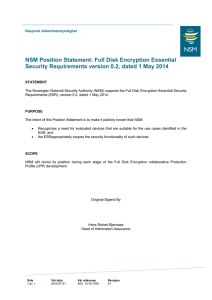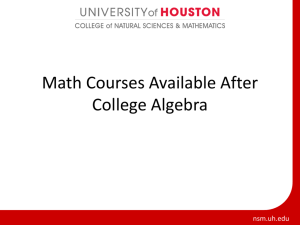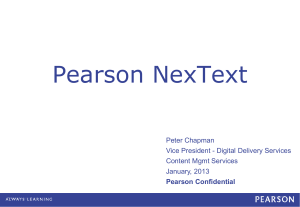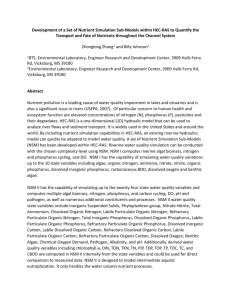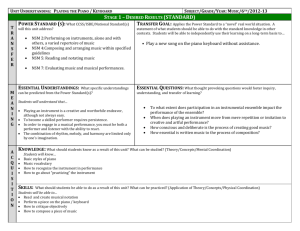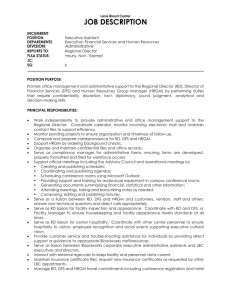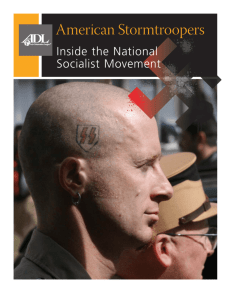MS-Word - American Society of Breast Surgeons
advertisement
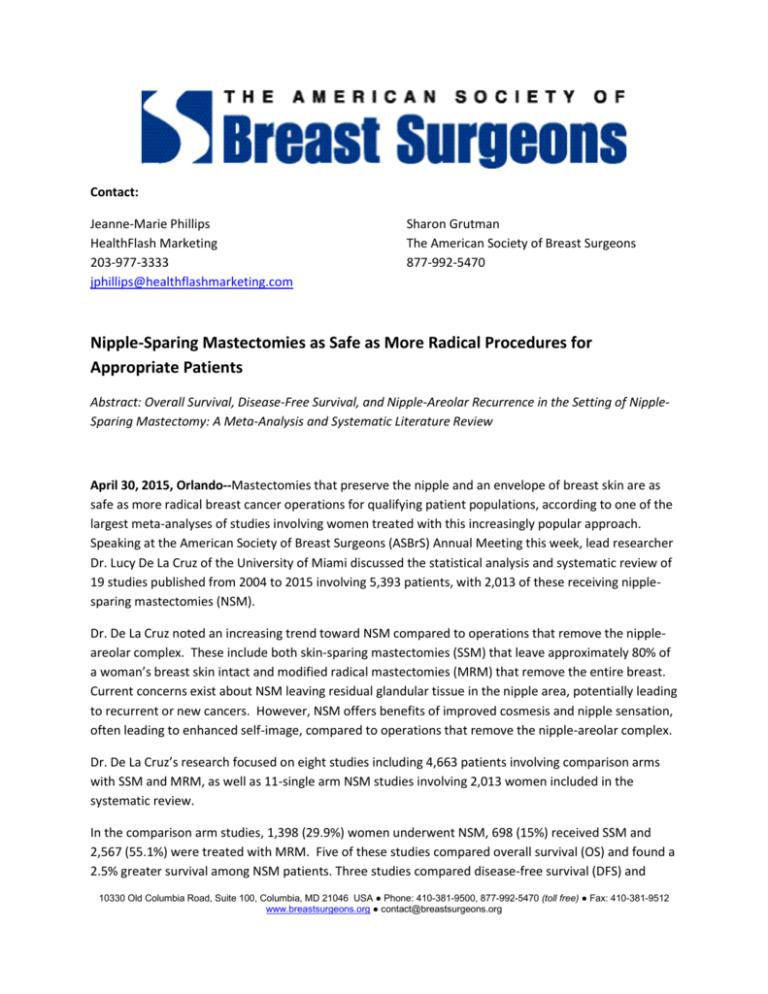
Contact: Jeanne-Marie Phillips HealthFlash Marketing 203-977-3333 jphillips@healthflashmarketing.com Sharon Grutman The American Society of Breast Surgeons 877-992-5470 Nipple-Sparing Mastectomies as Safe as More Radical Procedures for Appropriate Patients Abstract: Overall Survival, Disease-Free Survival, and Nipple-Areolar Recurrence in the Setting of NippleSparing Mastectomy: A Meta-Analysis and Systematic Literature Review April 30, 2015, Orlando--Mastectomies that preserve the nipple and an envelope of breast skin are as safe as more radical breast cancer operations for qualifying patient populations, according to one of the largest meta-analyses of studies involving women treated with this increasingly popular approach. Speaking at the American Society of Breast Surgeons (ASBrS) Annual Meeting this week, lead researcher Dr. Lucy De La Cruz of the University of Miami discussed the statistical analysis and systematic review of 19 studies published from 2004 to 2015 involving 5,393 patients, with 2,013 of these receiving nipplesparing mastectomies (NSM). Dr. De La Cruz noted an increasing trend toward NSM compared to operations that remove the nippleareolar complex. These include both skin-sparing mastectomies (SSM) that leave approximately 80% of a woman’s breast skin intact and modified radical mastectomies (MRM) that remove the entire breast. Current concerns exist about NSM leaving residual glandular tissue in the nipple area, potentially leading to recurrent or new cancers. However, NSM offers benefits of improved cosmesis and nipple sensation, often leading to enhanced self-image, compared to operations that remove the nipple-areolar complex. Dr. De La Cruz’s research focused on eight studies including 4,663 patients involving comparison arms with SSM and MRM, as well as 11-single arm NSM studies involving 2,013 women included in the systematic review. In the comparison arm studies, 1,398 (29.9%) women underwent NSM, 698 (15%) received SSM and 2,567 (55.1%) were treated with MRM. Five of these studies compared overall survival (OS) and found a 2.5% greater survival among NSM patients. Three studies compared disease-free survival (DFS) and 10330 Old Columbia Road, Suite 100, Columbia, MD 21046 USA ● Phone: 410-381-9500, 877-992-5470 (toll free) ● Fax: 410-381-9512 www.breastsurgeons.org ● contact@breastsurgeons.org 2 demonstrated a 4.4% difference favoring NSM. All eight studies examined local recurrence (LR) and found a consistent rate among all treatment groups. “Our hypothesis was that in the setting of breast cancer, nipple-sparing mastectomy is as safe as SSM and MRM,” commented Dr. De La Cruz. “The data clearly supports this. We believe that the small benefit shown for NSM in the study should be taken very lightly.” Nineteen studies provided data on nipple-areolar recurrence (NAR) for a total of 1,861 patients. For 547 patients followed for less than three years, the recurrence rate was .6%, while the 456 followed for three to five years showed a .5% recurrence and the 1,032 followed for more than five years had a 2.1% recurrence rate. Dr. De La Cruz noted that most women across all studies had stage 1 or 2 invasive ductal carcinoma (IDC) The final meta-analysis excluded all women receiving prophylactic mastectomies. “To amass a more statistically valid sampling, a meta-analysis looks at the findings of multiple studies which often involve a limited number of subjects at a single institution. Alternatively, prospective cancer registries such as the American Society of Breast Surgeons’ Nipple Sparing Mastectomy Registry are also extremely important to further rigorous scientific research on procedures such as this to benefit women in the future.” 10330 Old Columbia Road, Suite 100, Columbia, MD 21046 USA ● Phone: 410-381-9500, 877-992-5470 (toll free) ● Fax: 410-381-9512 www.breastsurgeons.org ● contact@breastsurgeons.org 3 Abstract, Official Proceedings Presenter: Lucy De La Cruz Institution: University of Miami Title: Overall Survival, Disease-Free Survival, and Nipple-Areolar Recurrence in the Setting of NippleSparing Mastectomy: A Meta-Analysis Objective: Surgical management of breast cancer has evolved since the Halsted era to preserve the breast skin envelope and nipple-areolar complex for enhanced cosmetic results. However, concerns exist regarding oncological safety of nipple-sparing mastectomy (NSM) due to potential for residual glandular breast tissue to harbor future cancer. The current study serves as a meta-analysis to evaluate overall survival (OS), disease-free survival (DFS), and nipple-areolar recurrence (NAR) in women undergoing NSM. Methods: A systematic literature review identified peer-reviewed studies published from 1991 to 2014 in MEDLINE, EMBASE, Cochrane Library, and PubMed, using key search terms (nipple-sparing mastectomy, subcutaneous mastectomy, and skin-sparing mastectomy). Two reviewers independently screened and selected articles using specific inclusion criteria. Descriptive statistics were determined using SPSS 22.0. An independent-samples t test compared mean OS, DFS, and NAR. Results: An analysis of 18 studies included 2,332 patients followed for an average of 44.7 months (range, 10.5-156). The mean patient age was 46.5 years (range, 35.6-52.8). Of 2,538 NSMs performed, 403 were prophylactic and 2,135 were therapeutic. The most common pathology was invasive ductal carcinoma (IDC). The majority of patients had stage I disease and 268 patients had positive lymph nodes. Average OS, DFS, and NAR were 96.3%, 90.9%, and 1.3%, respectively. Subgroup analyses compared studies evaluating only therapeutic NSM to studies evaluating both therapeutic and prophylactic NSM. The therapeutic subgroup included 8 studies with 1,476 patients followed for an average of 68.5 months (range, 21.7-156). The most common pathology was IDC. The most common presentation was evenly distributed between stages I and II, and 179 patients had positive lymph nodes. The combined therapeutic and prophylactic subgroup included 10 studies with 856 patients followed for an average of 25.7 months (range, 10.5-50.3). The most common pathology was IDC. The majority of patients had stage I disease, and 89 patients had positive lymph nodes. In the therapeutic subgroup, OS (93.0%) and DFS (84.2%) were less than in the combined subgroup (OS = 99.0% and DFS = 96.2%). NAR was greater in the therapeutic subgroup (2.6%) compared to the combined subgroup (0.4%). Differences in mean OS (p = 0.006), DFS (p = 0.012), and NAR (p = 0.001) between subgroups were all statistically significant. Conclusion: This meta-analysis confirms NSM’s oncological safety. However, subgroup analysis demonstrates significant differences in outcomes of therapeutic versus combined therapeutic and prophylactic NSM. Future studies need to stratify patients based on indication for NSM. Use of prospective data registries, notably the Nipple Sparing Mastectomy Registry, will aid further characterization of outcome measures. 10330 Old Columbia Road, Suite 100, Columbia, MD 21046 USA ● Phone: 410-381-9500, 877-992-5470 (toll free) ● Fax: 410-381-9512 www.breastsurgeons.org ● contact@breastsurgeons.org 4 Summary of Published Studies on Nipple-Sparing Mastectomy Outcomes Year Patients (n = 2332) Follow-up (months) Overall Survival (%) Adam 2014 67 36.0 98.0 94.1 0 Alperovich 2013 8 10.5 100 100 0 Benediksson 2007 216 156 76.4 51.3 4.0 Crowe 2008 110 41.0 99.1 96.3 0.7 De Alcantara-Filho 2011 200 10.4 99.5 99.5 0 Gerber 2003 61 59.0 85.2 72.1 1.5 Jensen 2011 99 60.2 100 100 0 Kim 2010 152 60.0 97.1 89.0 - Nava 2011 65 36.0 98.1 94.9 0 Poruk 2014 130 25.8 96.9 96.9 0 Rulli 2013 77 50.3 100 92.2 2.0 Sacchini 2006 123 24.6 99.2 95.9 0 Sakurai 2013 788 87.0 93.0 86.0 3.7 Shi 2012 35 68.0 94.2 88.6 5.4 Sood 2014 87 30.0 100 91.9 0.9 Sookahn 2008 20 10.5 100 100 0 Tancredi 2013 58 21.7 100 92.8 3.4 Voltura 2008 36 18.0 97.2 94.4 0 Study Disease-Free Nipple-Areolar Survival (%) Recurrence (%) 10330 Old Columbia Road, Suite 100, Columbia, MD 21046 USA ● Phone: 410-381-9500, 877-992-5470 (toll free) ● Fax: 410-381-9512 www.breastsurgeons.org ● contact@breastsurgeons.org 5 Abstract, Revised after Official Proceedings Publication Presenter: Lucy De La Cruz Institution: University of Miami Title: Overall Survival, Disease-Free Survival, Local Recurrence and Nipple-Areolar Recurrence: A MetaAnalysis and Systematic Review Background: The current study is a meta-analysis and systematic review to assess the oncological safety of nipple-sparing-mastectomy (NSM) through evaluation of overall survival (OS), disease-free survival (DFS), local recurrence (LR) and nipple-areolar recurrence (NAR). Methods: A systematic literature review was performed. Studies with internal comparison arms evaluating therapeutic NSM versus skin-sparking mastectomy (SSM) and/or modified radical mastectomy (MRM) were included in a meta-analysis of OS, DFS and LR. Studies lacking a comparison arm were only included in the systematic literature review to evaluate OS, DFS, LR and NAR. Results: The search yielded 851 articles, of which 19 studies with 5,276 patients met our selection criteria. Eight studies with comparison arms were included in the meta-analysis. Six studies compared OS in NSM to MRM/SSM and demonstrated a 2.5% risk difference favoring NSM. Three studies compared DFS in NSM to MRM/SSM and demonstrated a 4.4% risk difference favoring NSM. Eight studies compared LR rates in NSM to MRM/SSM and demonstrated no risk difference. All 19 studies were included in the systematic review of 2,011 patients to evaluate OS, DFS, LR and NAR. Patients followed <3 years, 3-5 years and >5 years had mean OS 98.6%, 97%, 90.8%; DFS 95.9%, 93.2%, 89.9%; LR 3.9%, 1.2%, 8.5%; and NAR 0.6%, 0.5% and 2.1%, respectively. Conclusions: This meta-analysis suggests NSM is as oncologically safe as MRM/SSM with regard to OS, DFS and LR. NAR was less than LR. Use of prospective data registries, notably the Nipple-Sparing Mastectomy Registry, will over time add additional clarity to this important clinical question. 10330 Old Columbia Road, Suite 100, Columbia, MD 21046 USA ● Phone: 410-381-9500, 877-992-5470 (toll free) ● Fax: 410-381-9512 www.breastsurgeons.org ● contact@breastsurgeons.org
